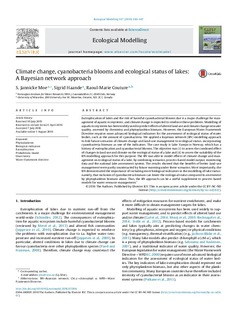| dc.contributor.author | Moe, S. Jannicke | |
| dc.contributor.author | Haande, Sigrid | |
| dc.contributor.author | Couture, Raoul-Marie | |
| dc.date.accessioned | 2018-09-13T11:02:28Z | |
| dc.date.available | 2018-09-13T11:02:28Z | |
| dc.date.created | 2016-09-09T12:31:14Z | |
| dc.date.issued | 2016 | |
| dc.identifier.citation | Ecological Modelling. 2016, 337, 330-347. | nb_NO |
| dc.identifier.issn | 0304-3800 | |
| dc.identifier.uri | http://hdl.handle.net/11250/2562487 | |
| dc.description.abstract | Eutrophication of lakes and the risk of harmful cyanobacterial blooms due is a major challenge for management of aquatic ecosystems, and climate change is expected to reinforce these problems. Modelling of aquatic ecosystems has been widely used to predict effects of altered land use and climate change on water quality, assessed by chemistry and phytoplankton biomass. However, the European Water Framework Directive requires more advanced biological indicators for the assessment of ecological status of water bodies, such as the amount of cyanobacteria. We applied a Bayesian network (BN) modelling approach to link future scenarios of climate change and land-use management to ecological status, incorporating cyanobacteria biomass as one of the indicators. The case study is Lake Vansjø in Norway, which has a history of eutrophication and cyanobacterial blooms. The objective was (i) to assess the combined effect of changes in land use and climate on the ecological status of a lake and (ii) to assess the suitability of the BN modelling approach for this purpose. The BN was able to model effects of climate change and management on ecological status of a lake, by combining scenarios, process-based model output, monitoring data and the national lake assessment system. The results showed that the benefits of better land-use management were partly counteracted by future warming under these scenarios. Most importantly, the BN demonstrated the importance of including more biological indicators in the modelling of lake status: namely, that inclusion of cyanobacteria biomass can lower the ecological status compared to assessment by phytoplankton biomass alone. Thus, the BN approach can be a useful supplement to process-based models for water resource management. | nb_NO |
| dc.language.iso | eng | nb_NO |
| dc.publisher | Elsevier | nb_NO |
| dc.rights | Attribution-NonCommercial-NoDerivatives 4.0 Internasjonal | * |
| dc.rights.uri | http://creativecommons.org/licenses/by-nc-nd/4.0/deed.no | * |
| dc.title | Climate change, cyanobacteria blooms and ecological status of lakes: A Bayesian network approach | nb_NO |
| dc.title.alternative | Climate change, cyanobacteria blooms and ecological status of lakes: A Bayesian network approach | nb_NO |
| dc.type | Journal article | nb_NO |
| dc.type | Peer reviewed | nb_NO |
| dc.description.version | publishedVersion | nb_NO |
| dc.rights.holder | © 2016 The Authors | nb_NO |
| dc.source.pagenumber | 330-347 | nb_NO |
| dc.source.volume | 337 | nb_NO |
| dc.source.journal | Ecological Modelling | nb_NO |
| dc.identifier.doi | 10.1016/j.ecolmodel.2016.07.004 | |
| dc.identifier.cristin | 1379708 | |
| dc.relation.project | EC/FP7/244121 | nb_NO |
| dc.relation.project | EC/FP7/603378 | nb_NO |
| dc.relation.project | Norges forskningsråd: 208279 | nb_NO |
| dc.relation.project | Norges forskningsråd: 244558 | nb_NO |
| cristin.unitcode | 7464,30,23,0 | |
| cristin.unitcode | 7464,30,19,0 | |
| cristin.unitname | Nedbørfeltprosesser | |
| cristin.unitname | Ferskvannsøkologi | |
| cristin.ispublished | true | |
| cristin.fulltext | original | |
| cristin.qualitycode | 1 | |

